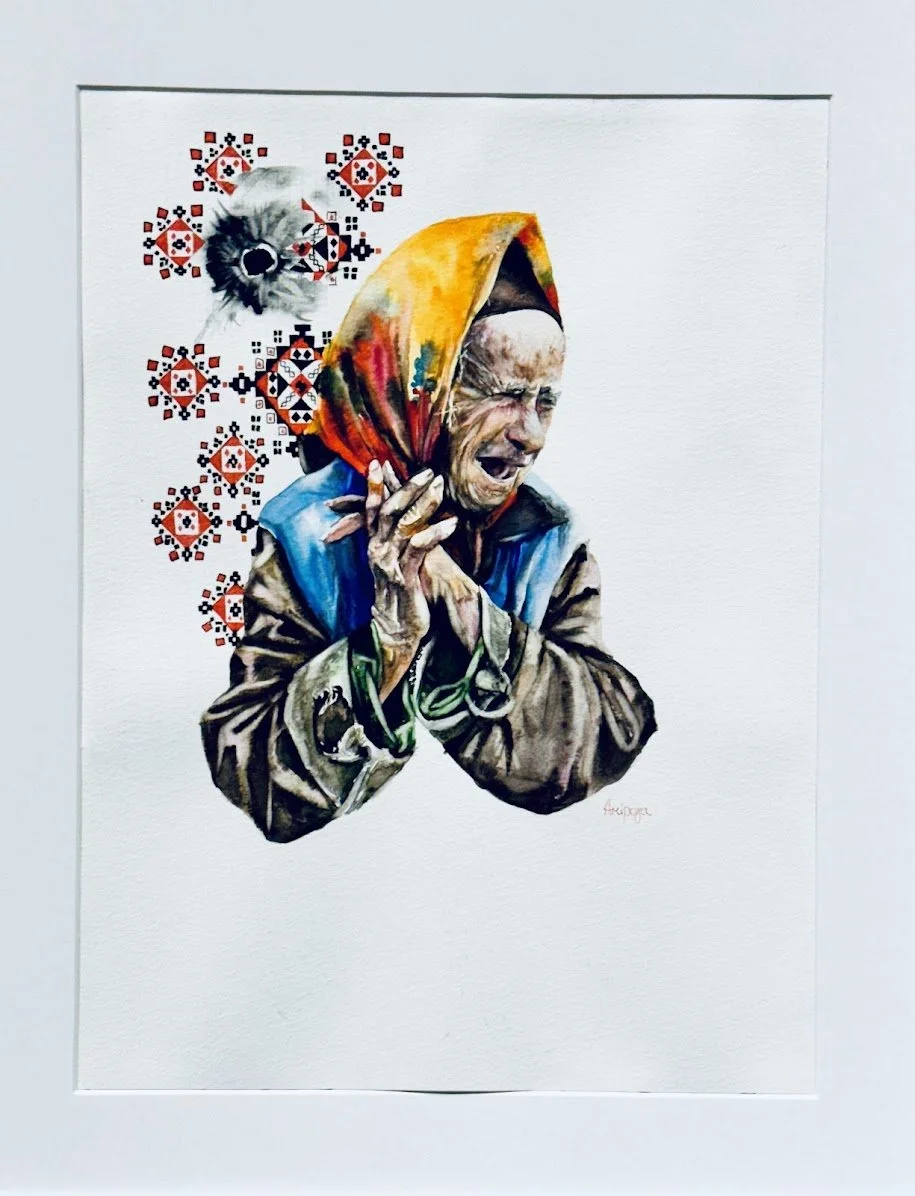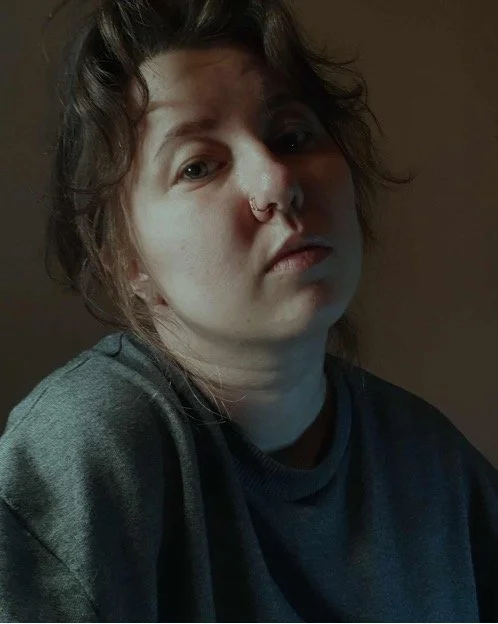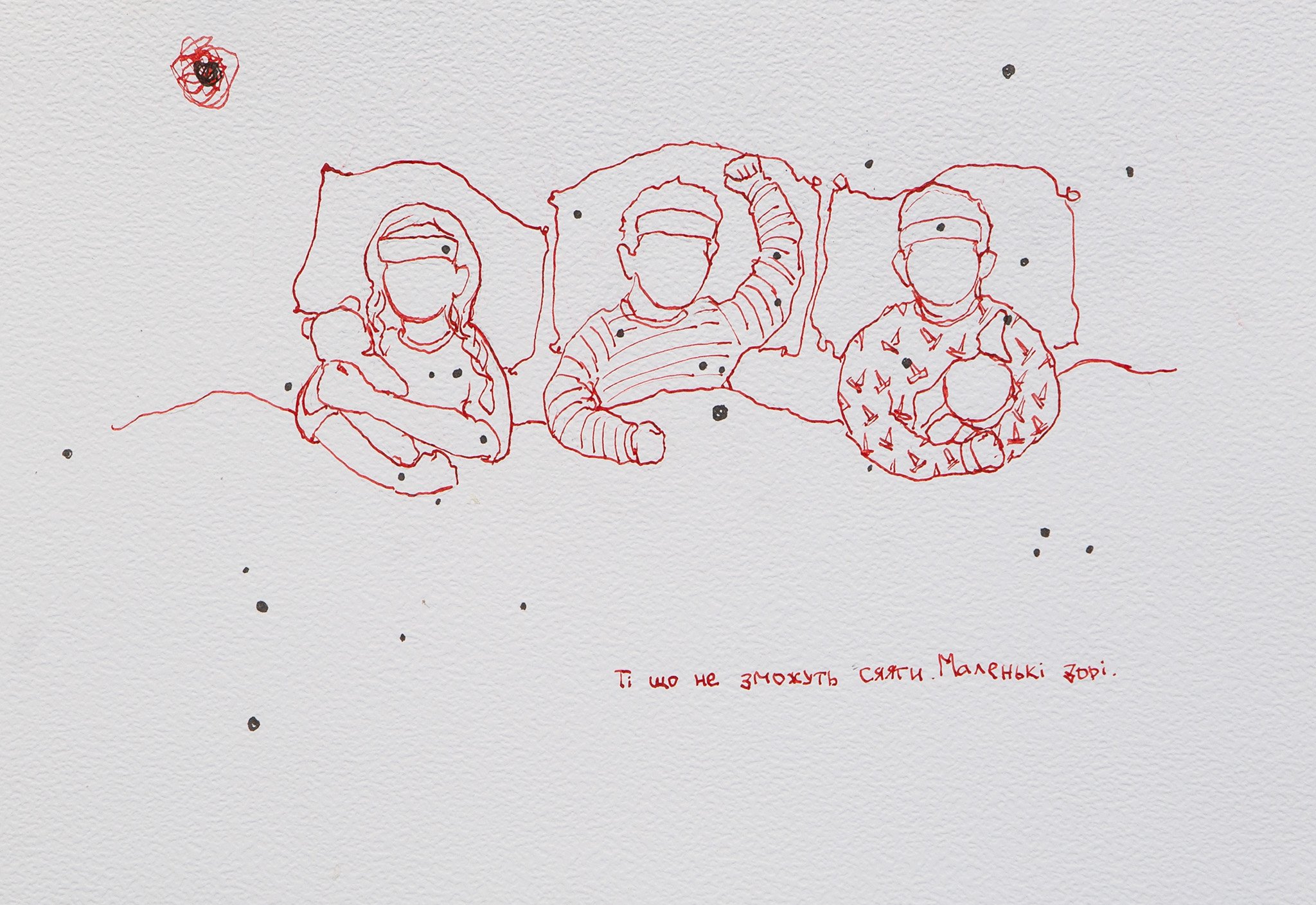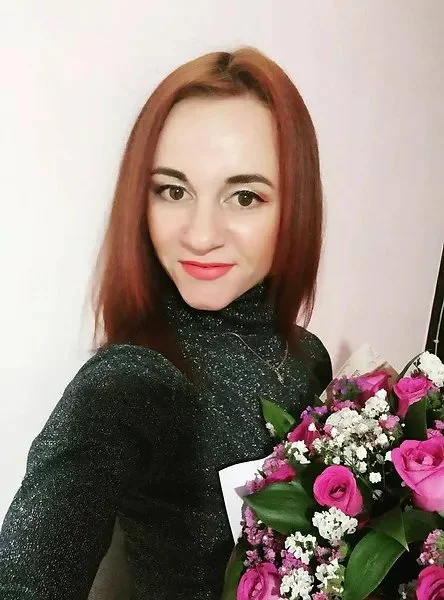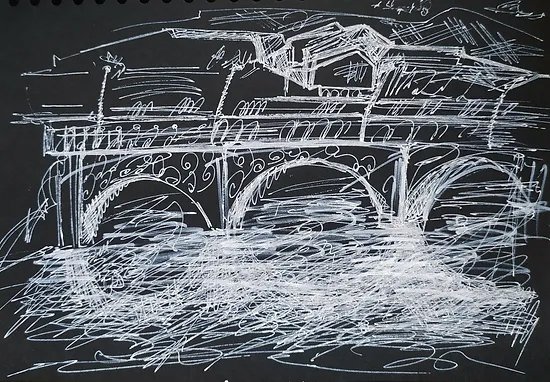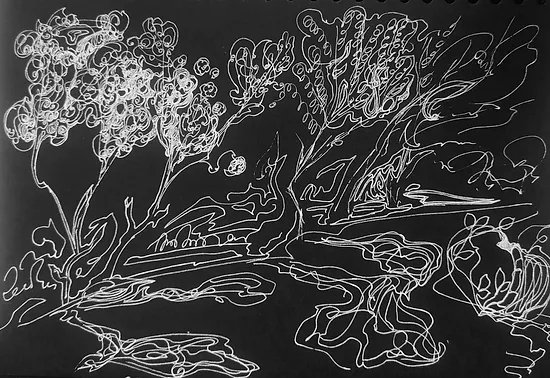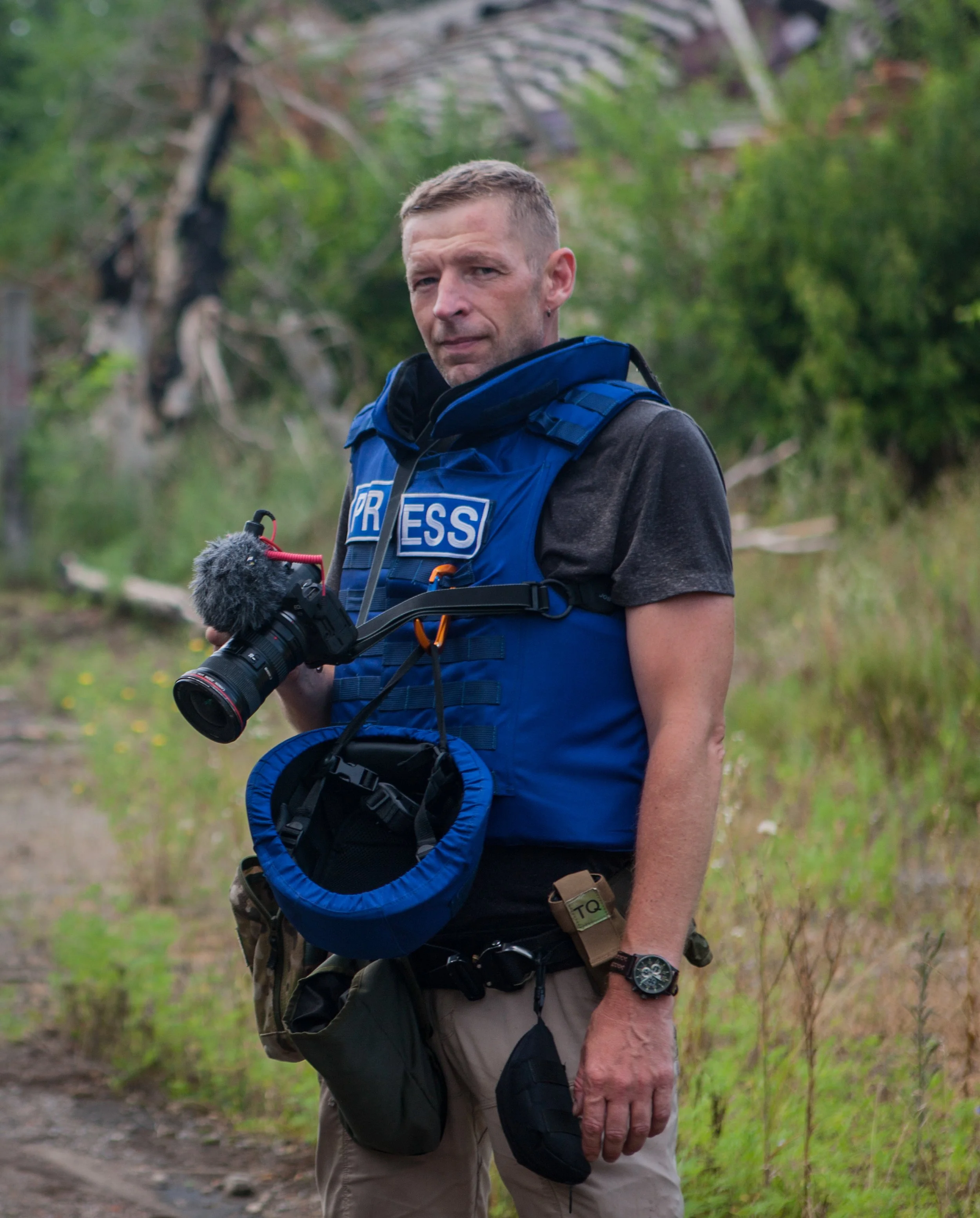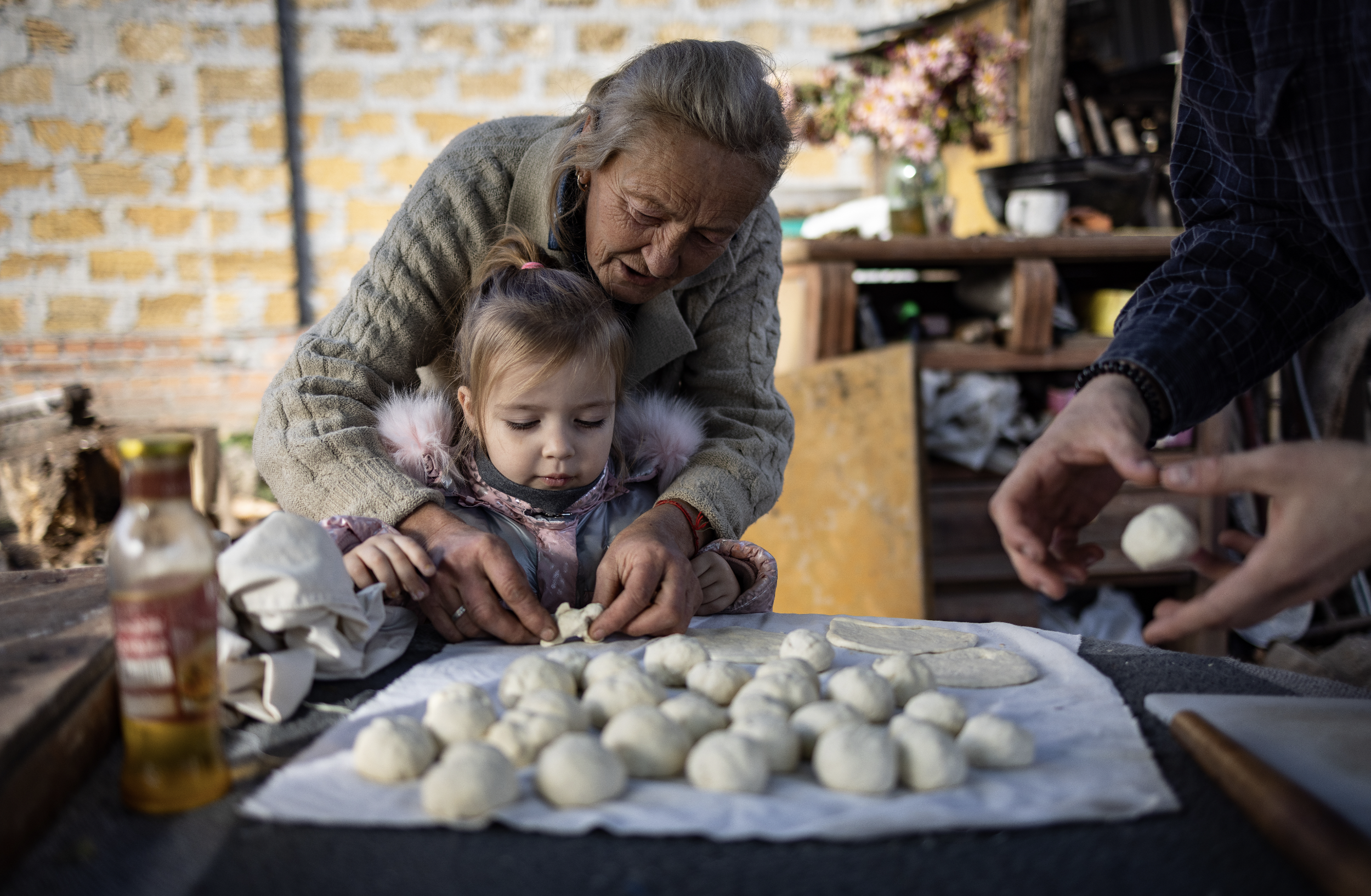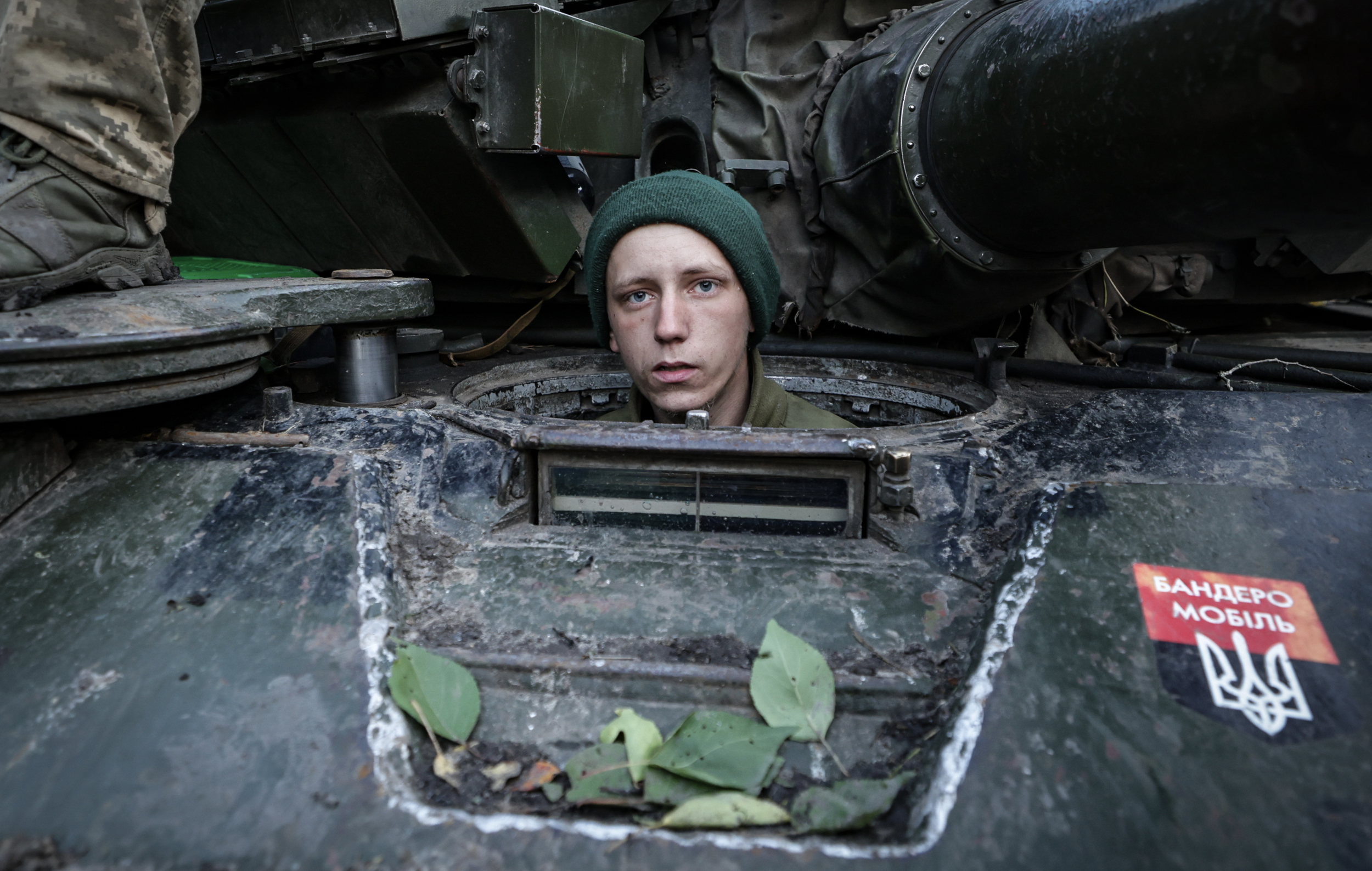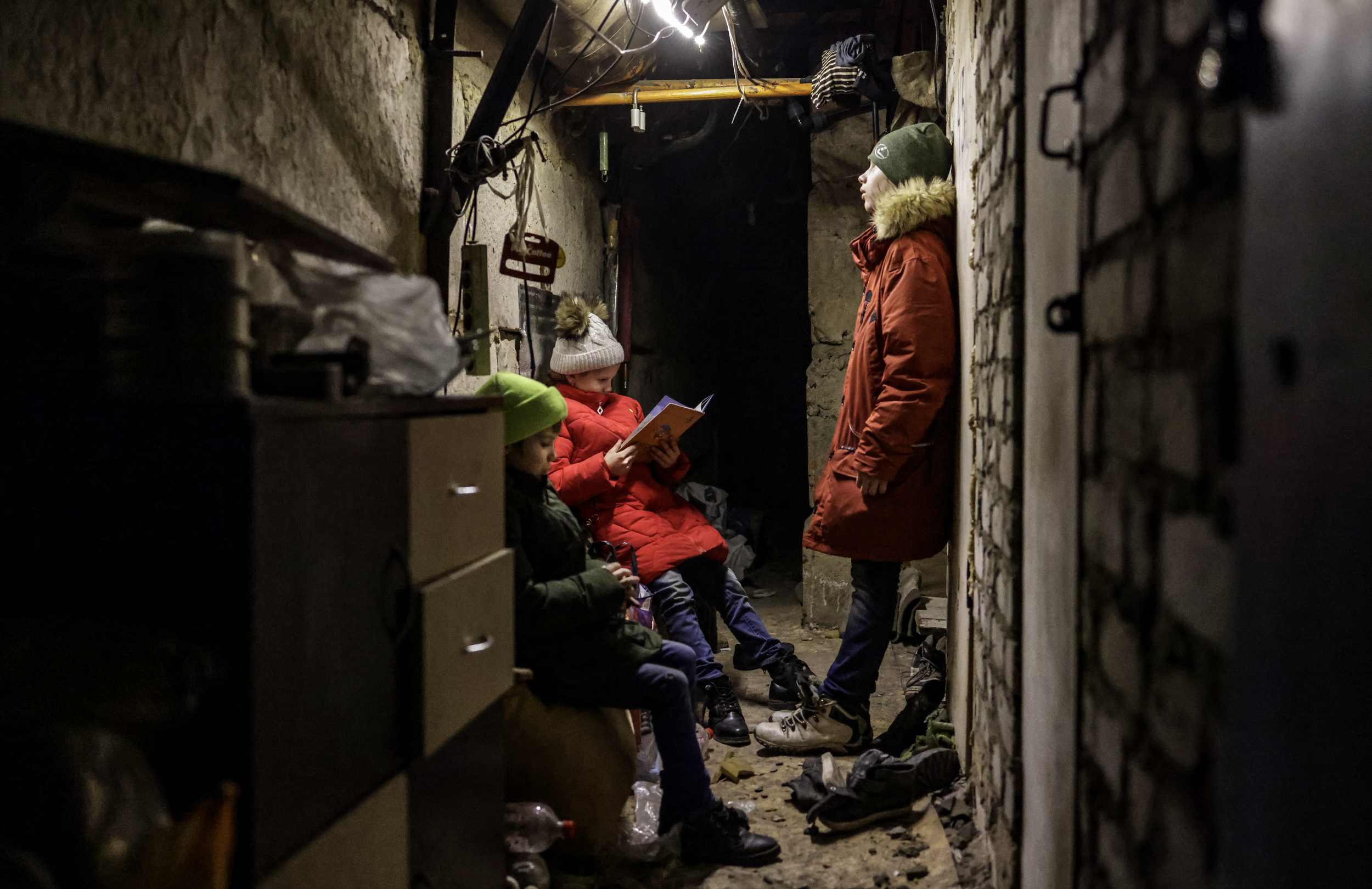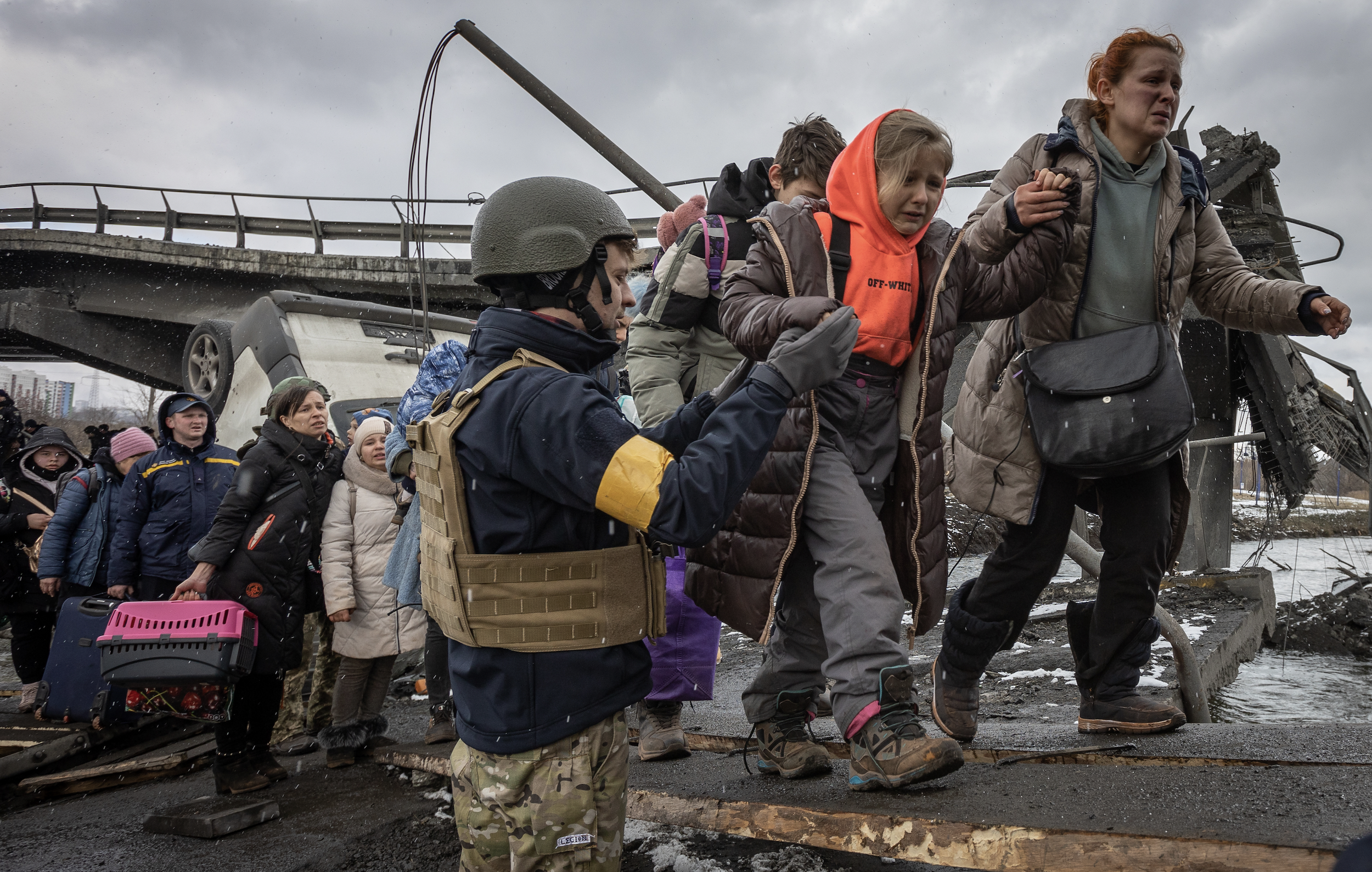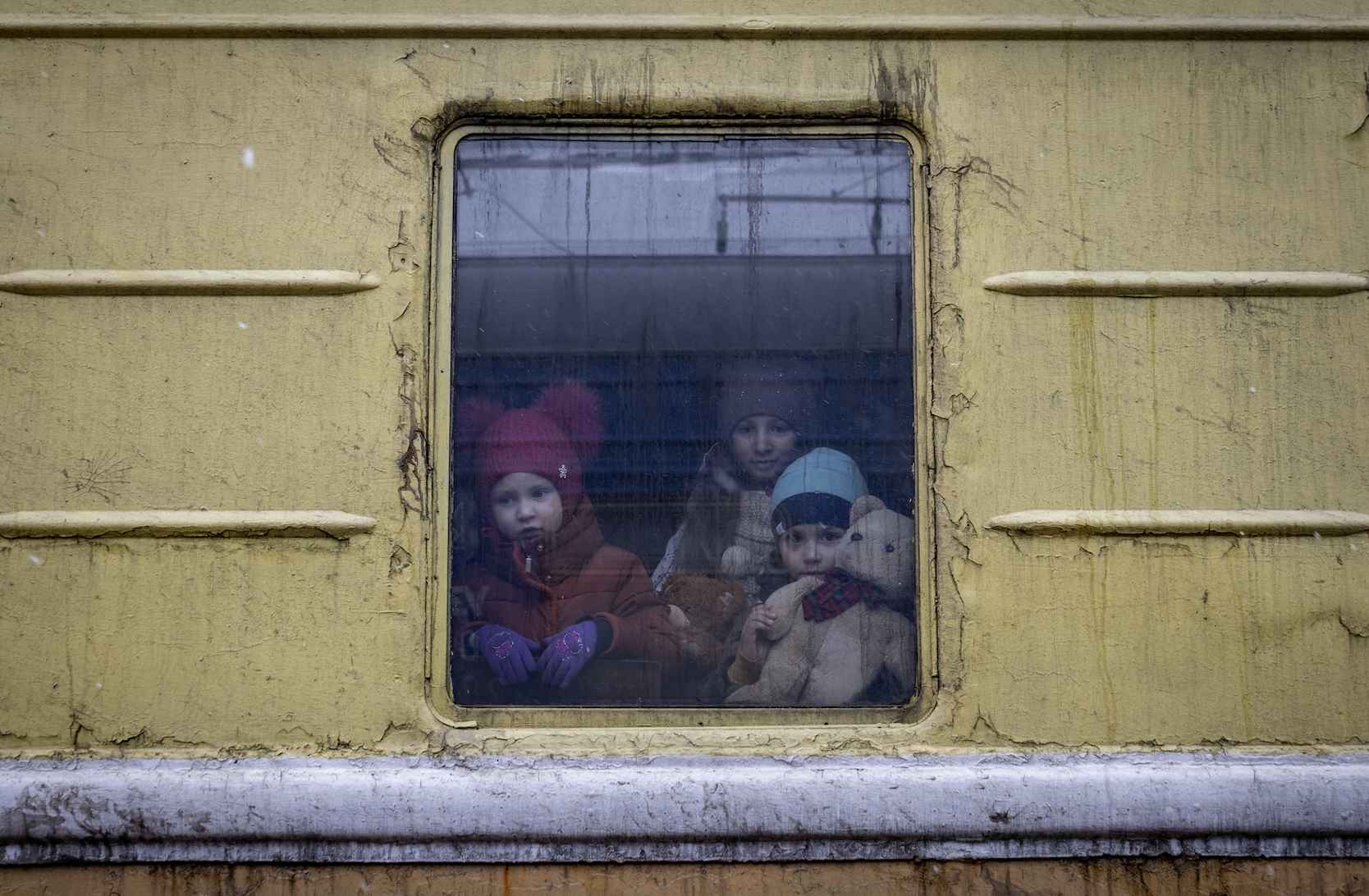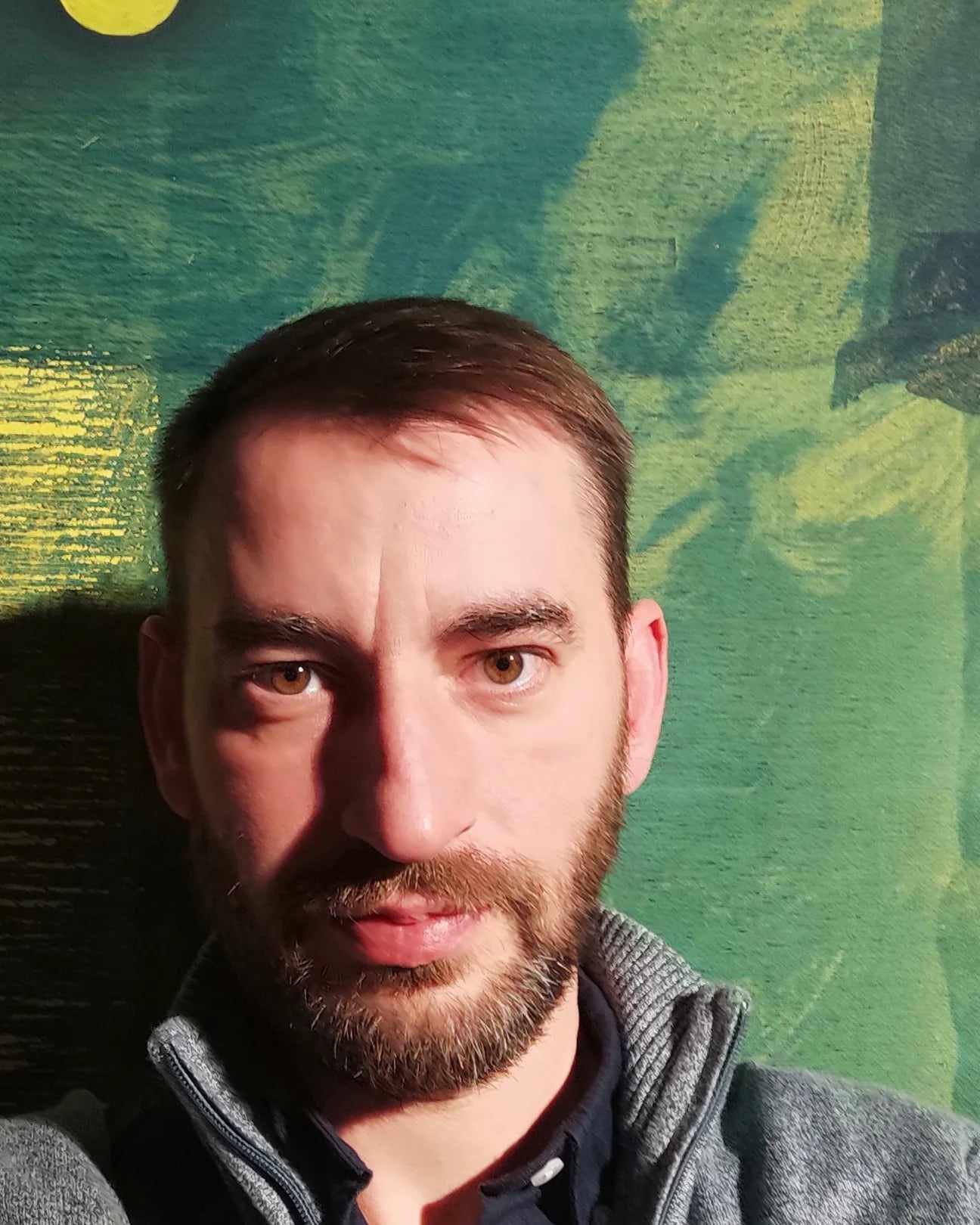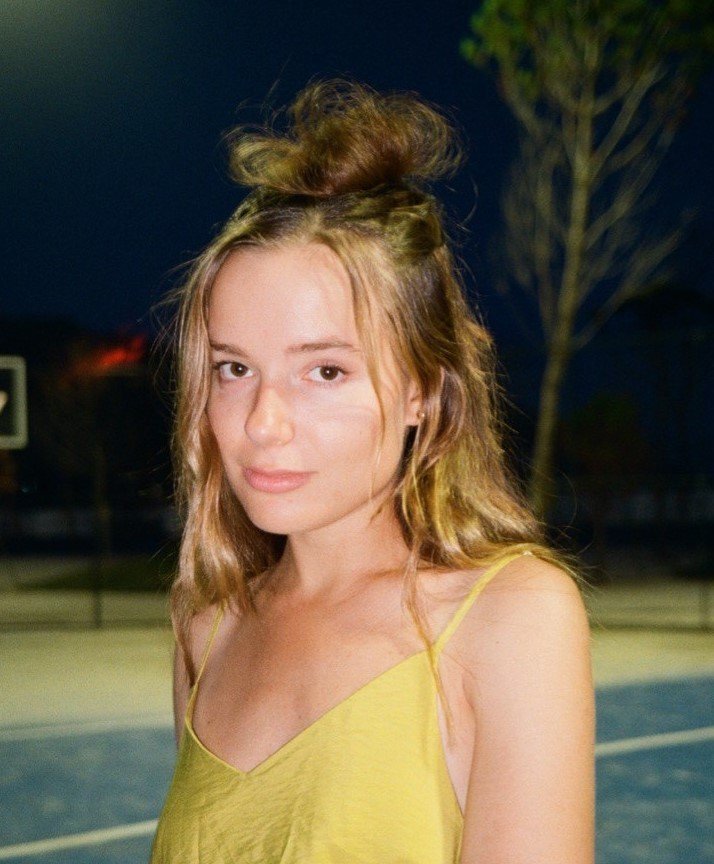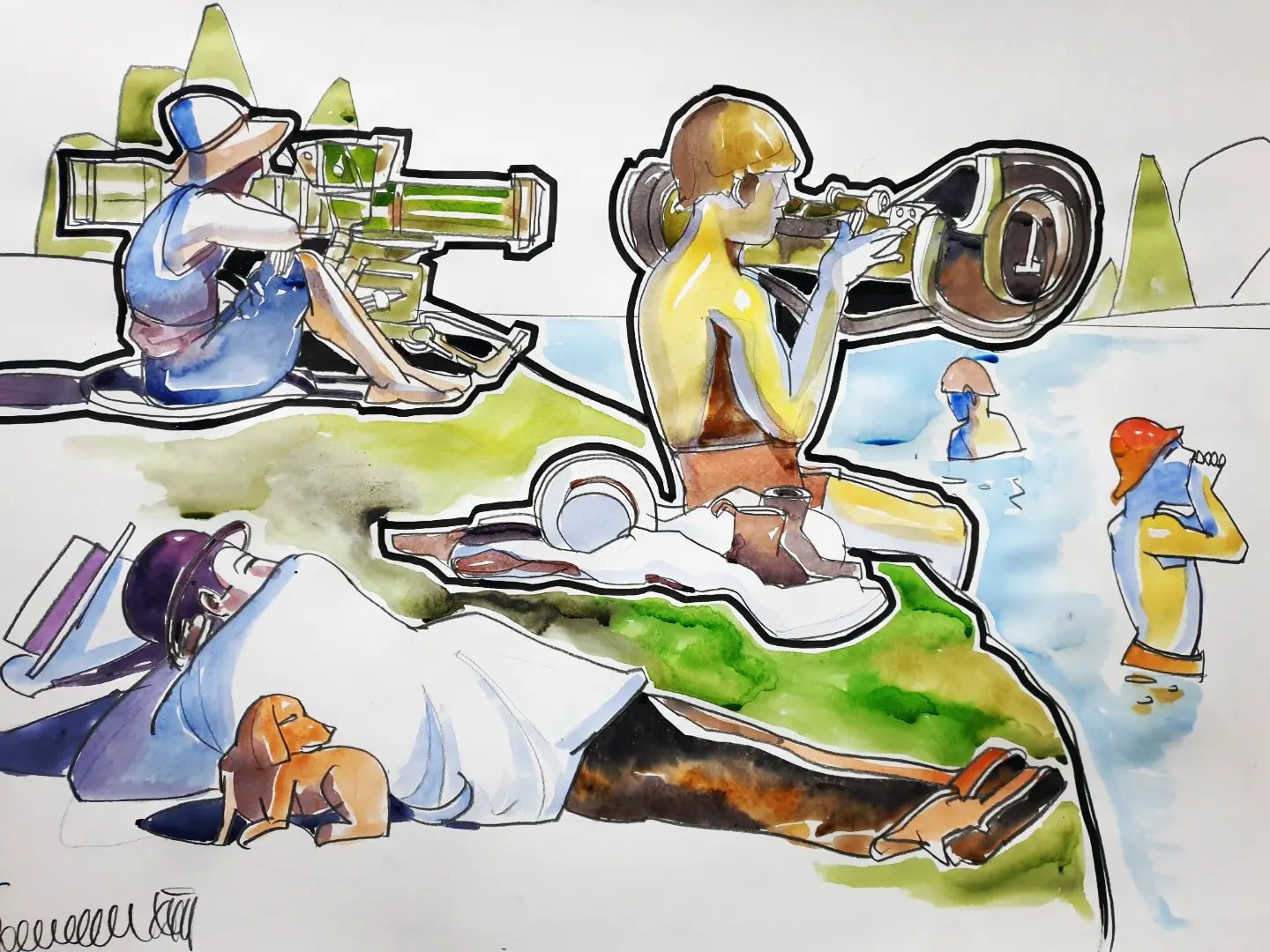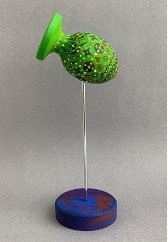A CLOSER LOOK: CONFLICTED ART FROM UKRAINE
/Upcoming Events
A CLOSER LOOK: CONFLICTED ART FROM UKRAINE
ПОГЛЯД ЗБЛИЗУ: КОНФЛІКТОВЕ МИСТЕЦТВО З УКРАЇНИ
September 16 - December 13
Buchanan Hall Atrium Gallery
Curated by Sophie Bae and Conflicted Art Yevgen Nemchenko
“In the cacophony of conflict, peace stands as a fragile ideal, elusive yet indispensable. Amidst the prevalent anger, hate, and noise, the imperative for peace resonates louder than ever.” - António Guterres, Former Secretary-General of the United Nations.
Kristina Otchich-Cherniak, Not Indifferent, 2022, Ink on paper, 12x9 in
Bombarded by relentless media coverage, individuals often feel powerless, leading many to overlook the deeper questions surrounding why, in the 21st century, countless lives continue to be devastated by war. This phenomenon often stems from our collective lack of empathy and our tendency to avoid confronting the atrocities unfolding before us.
Amidst this backdrop, there are artists who live and create within the context of war. Some resist authoritarian regimes through their art, while others advocate for peace. Some pose provocative questions, while others reflect on their subtle and personal observations. Some use art for propaganda, while others use it to foster unity.
Beyond the statistics in the news, A Closer Look delves into the core of existence, reshaping both communities and individual lives. Previously ordinary scenes now carry the weight of violence, as even the simplest activities are tinged with the looming threat of conflict. The once-familiar comforts of home no longer guarantee safety, and familiar streets now serve as evacuation routes. Businesses cautiously navigate their operations, responding to the ominous threat of unexpected attack. Assaults on civilian populations and vital infrastructure have tragically become commonplace. While individuals may go about their routines, glancing at their phones as usual, the content they receive paints a starkly different reality: warnings of imminent danger and devastation, rendering life untenable.
A Closer Look: Conflicted Art from Ukraine presents artistic responses to war through the works of 13 contemporary Ukrainian artists from the frontline. Through photography, video, painting, sculpture, and installation, these artists explore critical issues on the fault lines of conflict. Their works initiate a dialogue between viewers and the profound realities of conflict, encouraging and modeling resilience in the face of adversity.
Natalia Amirova, Kiss Before the Evacuation, 2022
watercolor on paper, 12x16 in
Kristina Otchich-Cherniak's simple ink drawings address pressing issues, including the brutal massacre of civilians, the courageous defiance of women against torture and rape, the senseless killing of animals, and the resilience of survivors amidst air raids and bombings. Natalia Shynkarenko draws inspiration from vintage chess boards, symbolic of a strategic battlefield where opposing forces vie for victory, often finding themselves trapped in positions with no escape. Elena Alyabyeva's White Town series depicts a journey from desperation, loss, and helplessness to a newfound sense of meaning, rebirth, and stability. Utilizing black paper to symbolize the darkness of war in Ukraine, contrasted with the hopeful imagery of a white town, Alyabyeva captures the memories of her surroundings. Natalia Amirova's watercolor portrait paintings, seemingly depicting everyday individuals, contain narratives influenced by her Ukrainian embroidery and journalism background, revealing the hidden psychological trauma that fractures communities and cultures.
Anatoliy Kvitka’s "Love Triangle" collages paradoxically address critical issues regarding geopolitical power struggles, offering a unique perspective on complex conflicts. Vitalij Zdebskij’s cartoons provide satirical perspectives on wartime propaganda, offering a critical commentary on contemporary conflicts and the manipulation of public opinion. Rusty Trawler illuminates working class society, reminding viewers to take collective responsibility to address human deficiency in empathy. Sergiy Simutin delves into the global famine born from conflict and neglect, exposing the harsh realities of human suffering and deprivation.
Roman Rabyk's closed-eyed upper body sculpture serves as an homage to the unwavering courage and resilience of Ukrainian soldiers, embodying their spirit amidst ongoing conflict. Eugene Baraban's metaphoric sculpture, resembling a traditional Ukrainian Easter egg, echoes the tensions of the current conflict, inviting reflection on cultural identity amidst conflict. Nata Levitasova's painting, "There Is No Safe Place Here," poignantly reflects the devastating impact of conflict and the elusive nature of safety amidst chaos. Roman Bonchuk infuses the scene with both vibrancy and tension, juxtaposing heightened tensions within the global military-industrial complex. Andriy Dubchak is a photo journalist who documents the experiences of those affected by conflict through portrait photography, offering the raw and unfiltered perspective of individuals and communities impacted by war.
The accompanying video about the book Voices of Freedom: Contemporary Writing From Ukraine expresses the enduring theme of freedom in Ukrainian literature, spanning a generational struggle for national identity.
Conflict is often perceived as a natural part of human existence, yet there is a critical need for more comprehensive efforts to prevent its escalation into violence. In navigating the challenges of today, 'A Closer Look: Conflicted Art from Ukraine' urges viewers to interact with the artworks, fostering understanding, reflection, and prompting contemplation on how we navigate and resolve conflicts in our own lives. Ultimately, this engagement fosters deeper insight into the human experience amidst conflict and provides a platform for the ongoing process of conflict resolution and peacebuilding.
Participating artists include: Kristina Otchich-Cherniak, Natalia Shynkarenko, Roman Rabyk, Natalia Amirova, Anatoliy Kvitka, Vitalij Zdebskij, Rusty Trawler, Sergiy Simutin, Nata Levitasova, Eugene Baraban, Roman Bonchuk, Elena Alyabyeva and Andriy Dubchak
About Conflicted Art
The project Conflicted Art is a collection of paintings, sculptures, and other forms of art by Ukrainian artists that were created right after the Russian invasion of Ukraine. It was conceived a few days into the war and was meant to show the war through the artists’ eyes as it was happening in the moment. Some works are an artist’s attitude to a specific event that happened during the course of the conflict, while others show an artist’s reflection on their feelings and their current situation. The project revealed a theme that while a certain amount of social change or even instability might be useful for an artist to draw inspiration from, the overall conditions and situation in which an artist creates must be at least somewhat comfortable. Otherwise, work might stop or take unpredictable forms. https://www.conflictedart.com/
INSTALLATION VIEW
PARTICIPATING ARTISTS AND ARTWORKS
Kristina Otchich-Cherniak, based in Kyiv, graduated from the National Academy of Management Personnel of Culture and Arts with a Bachelor’s degree in art criticism and from Wroclaw University with a Master’s degree in art history. Working primarily in mixed media, including graphics and embroidery, her artistic research delves into existential and philosophical themes, psychology, mental disorders, and the exploration of her own personality. Impacted by a traumatic event in her early adulthood, Kristina channels her thoughts and emotions through her artwork. Alongside her artistic endeavors, she has spent the past five years as an art teacher in Kyiv and has organized plein air sessions for a group of individuals in Cyprus. Her works are featured in private collections across Europe and the United States, showcasing the depth and breadth of her artistic vision and expression.
This exhibition presents 12 letter-paper drawings capturing moments of intense contention amidst the turbulent and harrowing realities of conflict and war. From the profound impacts of displacement, trauma, and violence to the horrors of massacre and sheer fatigue, the artist delves into a range of pressing issues. Through her artwork, she not only pays homage to the resilience of survivors but also seeks to honor the memory of those profoundly affected by the harsh realities of conflict.
Not Indifferent, 2022, Ink on paper, 12x9 in
I Am Alive, 2022, ink on paper, 12x9 in
Are We Not Going Anymore, Mother?, 2022
ink on paper 9x12 in
On April 13, 2022, about 20 women came to the Russian embassy in Tallinn, Estonia. The women, their legs and underwear stained with red paint, their hands bound behind their backs, and black plastic bags covering their heads, stood in defiance against the widespread evidence of torture and rape inflicted upon women and children by Russian soldiers in Ukraine. Through this striking depiction, Kristina honors the bravery and resilience of these women who refused to remain indifferent in the face of injustice.
Kristina Otchich-Cherniak's artwork, "I Am Alive," provides a poignant portrayal of the resilience and tragedy witnessed during the April 8th events in Kramatorsk, Ukraine. The piece captures the harrowing moments when approximately four thousand individuals gathered at the train station amidst fears of a potential Russian attack. These fears materialized at 10:28 am, as Russian forces launched a devastating strike with a cluster ammunition rocket known as 'Tochka-U,' resulting in the loss of 61 lives and leaving 110 others wounded. Among the survivors was twelve-year-old Yana Stepanenko, who tragically lost both of her legs, while her mother faced a similar fate. Despite the immense challenges she faced, Yana Stepanenko defied the odds by participating in her first Boston Marathon, a testament to her indomitable spirit and the power of resilience in the face of adversity.
For additional information, click here: Yana Stepanenko - Boston Marathon.
In the aftermath of the devastating attack on the Kramatorsk train station by the Russian army, where thousands had gathered in hopes of evacuation, the toll was staggering, with 61 lives lost. This evocative drawing reflects upon a poignant moment captured in the event's documentation: a solitary blue stroller amidst a blood-stained pavement, surrounded by scattered luggage. The imagery depicted here resonates with profound symbolism. The circular railroad track serves as a potent metaphor for the inexorable force of fate, highlighting the fragility and ultimately, the futility of our carefully laid plans in the face of such tragic circumstances.
For additional information, click here
Elena Alyabyeva was born in Kharkiv, a big industrial city in Eastern Ukraine very close to the border with Russia. Her artistic evolution, and the upheaval caused by the Russian invasion deeply influenced her work. Fleeing the conflict, Elena and her family experienced the hardships of displacement, finding refuge in Uzhhorod. Despite the challenges, Elena found solace in art, expressing her resilience through vibrant yet grounded compositions.
The White Town series chronicles a profound journey from despair, loss, and vulnerability to newfound purpose, renewal, and stability. Serving as the artist's introspective exploration of the past, it offers a poignant lesson in embracing the present and striving for a brighter future. It encapsulates Elena's realization that returning to her native city will be a transformed experience, marked by a commitment to savoring every moment with greater richness and significance. Each drawing is a vivid portrayal drawn from life experiences. The initial pieces, created daily over six days, vividly capture a rapid evolution following a month of anguish and frustration, while the final two serve as a poignant conclusion to the series.
Natalia Shynkarenko's artistic journey began in childhood, an enduring passion she pursued alongside a career in medicine. Despite her professional commitments, she dedicated herself to refining her artistic talents through private lessons and formal education at Grausten Art School in her hometown of L’viv.
Amidst the tumult of conflict, Natalia found solace and inspiration in vintage chess boards, each representing a strategic battlefield where opposing forces vie for victory, sometimes finding themselves in positions where escape is impossible. Sourcing these boards from local flea markets, she transforms their surfaces into canvases, using the checkered patterns as a springboard for her creative expression.
Battleship, 2022, oil on vintage chess board, 12x12 in
Natalia Amirova, based in the Polianytsia village in the Carpathian Mountains, boasts a diverse background that includes a successful career in journalism. Beginning her journalistic journey at the age of 17, Natalia won a United States grant that enabled her to launch a talk show in her hometown of Horlivka. Over the years, she has worked for various television channels in Ukraine, including during the tenure of the current mayor of Kyiv, Vitali Klitschko.
Through her journalistic pursuits, Natalia refined her abilities in composition and storytelling, a journey that profoundly shaped her transition into the realm of art. Although primarily self-taught, Natalia characterizes her style as a blend of photorealism and surrealism. Drawing from her Ukrainian heritage and journalistic background, her artwork often incorporates elements of Ukrainian embroidery(вишиванка). Natalia's artwork has garnered international recognition, with exhibitions in Greece and acquisitions by private collectors in Germany, the United States, and Australia.
Roman Rabyk, based in Lviv, is a contemporary Ukrainian artist. Rabyk addresses subjects that are important to him, such as choice, freedom, self-awareness, and human existence, with a variety of styles and techniques. With a diverse range of styles and techniques at his disposal, Rabyk fearlessly tackles these weighty subjects, often challenging established norms and perspectives. His works are not merely visual representations but rather conduits for introspection and contemplation. Veiled in mystery, many of his pieces harbor secrets, carefully woven into the fabric of their creation. However, Rabyk is content to let these enigmatic elements linger, allowing viewers to unravel their mysteries at their own pace.
The sculpture Prayer, 2024 stands as a tribute to Ukrainian soldiers engaged in the ongoing struggle against Russian occupation. Their unwavering courage and sacrifice echo through its form, a testament to their unyielding resolve. Roman Rabyk, the artist behind this creation, invokes the timeless aphorism, "There are no atheists in foxholes," reminding us of the universal human impulse to seek solace in moments of crisis. In times of war, regardless of faith or creed, the fervent desire for divine intervention persists—a beacon of hope amidst turmoil and uncertainty.
Andriy Dubchak is the Founder and CEO of the independent media outlet, Donbas Frontliner, renowned for his multi-faceted roles as a photographer, reporter, social media manager, and web expert. He gained widespread recognition as the first live streamer of EuroMaidan, documenting pivotal moments of the Revolutionary Events, notably the tragic days of February 18, 19, 20, 2014. His coverage extended to the annexation of Crimea by the Russian Federation, where he provided firsthand accounts to international audiences.
Hailing from the city of Kalinovka in the Vinnytsia region of Ukraine, Andriy holds a master's degree in Mechanics from Vinnitsa, as well as a degree in Network Engineering from Kyiv Polytechnic Institute. He further honed his skills in journalism at the Mohyla School of Journalism and pursued photography studies at the Kiev Photography School. Currently, Andriy's primary focus is on covering the ongoing conflict with Russia in Eastern Ukraine.
He earned a 2022 Free Media Award for his courageous reporting from battle zones and received accolades such as the European Lovie Awards and a Gold Medal in the LifePressPhoto competition. Dubchak's work has been exhibited internationally, including in India, Belgium, New York, London, and the Czech Republic. Notably, he co-produced and contributed cinematography to the Oscar-nominated film "Winter on Fire: Ukraine's Fight for Freedom" in 2015. He is also a recipient of the Order of Merit of Ukraine.
https://www.instagram.com/frontliner/ www.frontliner.com.ua https://www.andriy-dubchak.com.ua
A group of volunteers has been cooking food for eight months and distributing it to locals on one of the streets in occupied Kherson. At the photo: 59 years old Tatiana Lukashchuk teach daughter of one of the volunteer how to made simple bread. Liberated Kherson, 14 November 2022
Children with Ukrainian flag and uniform show «Victory» at the central square of Kherson during celebration of liberation of the city by Ukrainian army, 12 November 2022
The eyes of the Ukrainian mechanic-driver of the captured (trophy) russian tank who took part in the liberation of Lyman, Kharkiv region, 3 October 2022
Gleb (8 years old), Myroslava (9 years old), and Danya (12 years old) in their storage basement in central Bakhmut. They are positive and open, despite the hell around them. All the homes in this area are destroyed. Explosions are heard every second both near to them and on the outskirts of the city. The constant explosions come from shells, mines, hailstones, cluster ammunition and rockets. Fight for Bakhmut now is one of the most bloody battle since the russian invasion. Bakhmut, 19 December 2022
Ukrainians cross an improvised path under a destroyed bridge while fleeing Irpin, in the outskirts of Kyiv, Ukraine, Tuesday, March 8, 2022. Demands for ways to safely evacuate civilians have surged along with intensifying shelling by russian forces. Efforts to put in place cease-fires along humanitarian corridors have repeatedly failed amid Russian shelling.
Children in the window of a special evacuation train from Kharkiv to Lviv passing through Kyiv. The car of the train is closed. There is no heating or water in there and the toilet does not work. While boarding the train in Kharkiv, people heard powerful explosions and were forced to hide with their children in a bomb shelter several times. Kyiv Railway Station, March 3, 2022
Anatoliy Kvitka, a self-taught artist, has emerged as a prominent creative force in Ukraine. His artistic process is characterized by the transformation of thoughts into vivid visualizations that materialize into art. Working with found materials, Anatoliy explores a diverse range of genres, from poster art to abstract to Dadaism, often shedding light on pressing social issues through his unique perspective. His artworks have been showcased in numerous exhibitions across Ukraine, including prestigious venues such as Bilyi Svit Art Space, the Kyiv House of the Artist, and most recently, 'Transformations' in Lviv. Beyond his artistic endeavors, Anatoliy is also a poet and a leading figure in the RID Ukrainian literary movement, further cementing his role as a multifaceted cultural contributor.
Love Triangle presents a nuanced perspective on the ongoing conflict, depicting it as a multifaceted struggle involving three major players: Russia represented by the ruble, the United States by the dollar, and Ukraine by the hryvnia. Beyond mere assistance, the United States is seen as pursuing distinct geopolitical objectives within the region.The artist interprets that Ukraine is positioned at the epicenter of a larger global power struggle, coveted by all parties involved.
Nata Levitasova received her education at the Shevchenko State Art School T.G. Shevchenko State Art High School, Faculty of Painting in 2014, and later pursued studies at the Ukrainian Academy of Printing, graduating in 2018. As an artist, she explores themes such as industrialization, the encroachment of cities on natural landscapes, and human loneliness in the modern era. The basis and an integral part of every work is the color that reveals the emotionality. Recently, against the background of tragic events in Ukraine, the artist turned to the theme of war, creating a series of paintings “PAINted”. The works depict bloody crimes against humanity, the destruction of cities. Her artworks have been showcased in numerous exhibitions, with a notable residency at Les Abattoirs, Musée in Toulouse, France.
Depicting a fragment of a building in ruins, it reflects the devastating impact of the invasion that Nata and her husband had anticipated but were unprepared for. As they witnessed reports of leveled buildings and devastated cities, Nata felt compelled to channel her emotions into her art, using it as a lifeline amidst the chaos unfolding around them. Their home in the Carpathian Mountains of Ukraine, where they had recently settled, quickly transformed into a refuge for displaced relatives fleeing from the East, filling every corner with the displaced. However, even within the sanctuary of their home, safety remained elusive. The title of the painting underscores this grim reality, suggesting that nowhere offers true refuge amidst conflict. This sentiment is tragically echoed by the untimely demise of Nata's grandfather, who fell victim to a heart attack triggered by a nearby explosion on the second day of the invasion.
Born in Ivano-Frankivsk, Roman Bonchuk is a versatile artist, designer, restorer, and art director. His diverse academic journey, including studies at the Ivano-Frankivsk Art School and a seven-year painting study with Vladimir Chernyavsky, culminated in an invitation to Harvard University, where he explored Ukrainian literature of the 20th century. Bonchuk's artistic range spans impressionism, realism, surrealism, and abstractionism, reflecting a fearless exploration of materials and a commitment to pushing artistic boundaries. Inspired by a myriad of sources, his work captures the essence of human experience, history, and emotion. Notable creations include the "Megahistory of Ukraine" and mural paintings adorning landmarks in Ivano-Frankivsk.
Drawing inspiration from Georges Seurat's masterpiece, 'Bathers at Asnières,' renowned for its serene depiction of bathers by the Seine, Bonchuk's interpretation takes a strikingly different turn. While Seurat's bathers luxuriate, seemingly unaware of one another, Bonchuk injects the scene with vibrancy and tension.
Waiting for the Occupant, 2022, watercolor on paper, 22.5x32.5 in
Amidst ongoing geopolitical tensions, particularly between Russia and Western powers, Ukraine emerges as a focal point. Bonchuk's bold reinterpretation serves as a powerful warning: as Ukraine braces for its adversary, it stands as a stark reminder that the specter of conflict could soon engulf Europe if Russia's aggression is left unchecked.
The Temple of Spirit, Heroism, and Freedom, 2022 watercolor on paper, 33.5x47.5 in
Long before Mariupol's Azovstal Iron and Steel Works became a pivotal battleground in Ukraine, it stood as a cornerstone of the port city's economy. As one of Europe's largest metallurgical factories, it annually produced over 4 million tons of crude steel, sustaining tens of thousands of livelihoods.
However, amidst the devastating conflict and a prolonged siege by Russian forces, the sprawling industrial complex ceased its steel production. Instead, it has transformed into a refuge and final stronghold for thousands of Ukrainian fighters, including many from the Azov Battalion, one of Ukraine's most skilled and controversial military units.
Amidst the chaos, up to 1,000 civilians seek refuge within the network of underground tunnels, seeking shelter alongside hundreds of fighters within the confines of the Azovstal steel works.
Rusty Trawler, inspired by a character from "Breakfast at Tiffany’s," initially emerged as a graffiti artist before delving into self-study of art history and visual aesthetics. Rusty's work serves as a platform for social commentary on both contemporary and historical events, aiming to shed light on society's vices through an experimental lens. He had personal exhibits in Lviv, participated in events in Slovakia, and took part in art fairs in Kyiv. Through his bold and innovative approach, Rusty Trawler continues to challenge norms, spark dialogue, and push the boundaries of artistic expression. Pyramid of Needs, 2022 echoes Maslow's Hierarchy of Needs, employing human figures to delineate the pyramid's stages. As individuals ascend, their needs evolve from basic survival requirements to more complex facets of self-discovery and fulfillment.
Yet, amidst this progression, the jarring presence of "WAR" emblazoned on each forehead starkly underscores the pervasive impact of conflict, with fear etched across their faces. Notably, those occupying the lower rungs of society, visibly marked by their attire, emanate a heightened sense of vulnerability and apprehension.
The piece sheds light on a disquieting reality: a pervasive sense of silent complicity in the face of unfolding events in Ukraine and beyond. Despite universal acknowledgment that such circumstances should not prevail, many individuals remain passive spectators rather than agents of change. This passivity unwittingly fans the flames of conflict, perpetuating the cycle of violence. Ultimately, the artwork serves as a poignant reminder of our collective responsibility and the imperative to confront injustice, lamenting our shared deficiency in empathy and our extraordinary capacity to ignore the plight of others.
Sergiy Simutin is a versatile artist known for his graffiti, printmaking, and graphic work, influenced by his street art background. Originally trained as an electrician, he later pursued further education while working at Gorsvet. At 20, he felt compelled to explore his artistic side, leading him to drawing. His works were exhibited at art festivals and galleries throughout Ukraine and Poland, most notably the renowned Karas Gallery in Kyiv. Known as the breadbasket of Europe, Ukraine's crucial role in the global food supply was underscored in 2022 when Russia began blocking grain shipments from the country. This posed a risk of starvation not only locally but also in underdeveloped nations worldwide.
In his artwork, Sergii portrays two crops as symbolic icons, representing the essence of his message. The meticulous shading on the crops breathes life into them, enhanced by nimbus and gold details that illuminate the piece. Dominated by black tones, the paintings exude a somber and almost ominous aura. While the lines are impeccably executed, occasional visible strokes add a touch of humanity to the work. Many of them tragically lost their lives, as the most fertile agricultural lands became battlegrounds of intense fighting.
Based in Kyiv, Eugene Baraban is a self-taught artist with a diverse range of artistic talents spanning graphics, acrylic painting, assemblage, sculpture, and installation. His creative arsenal includes mediums such as ink, acrylic, oil, varnish, ceramics, wood, and metal. Additionally, he collaborates with factories to craft intricate art objects, including flexible neon products.
Eugene's work often delves into social themes, surrealism, and animalistic genres, imbued with a touch of post-irony that adds depth and complexity to his art. The sculpture features a pysanka, a traditional Ukrainian Easter egg adorned with intricate patterns.
Dating back to the 15th century, pysankas were historically used for protection against evil spirits. However, Eugene's interpretation subverts this tradition by depicting the pysanka on its side, elevated above the ground. This unconventional positioning transforms the symbol of protection into a menacing object resembling a bomb, blurring the line between defense and aggression. Painted in a pseudo-folk style on an acidic green background, the pysanka exudes both beauty and threat. The inclusion of a stand, reminiscent of a water surface, adds depth to the piece's interpretation. Ironically, shortly after the creation of this sculpture, the Russian flagship "Moscow" was sunk by a Ukrainian cruise missile in the Black Sea, echoing the tensions depicted in Eugene's artwork.
Vitalij Zdebskij is a graduate of the Donetsk College of Arts and the Kharkiv State Academy of Design and Art, with a specialization in graphic art. Inspired by pop culture and global events, he is equally adept at creating collages and assemblages. Vitalij's work often offers a satirical perspective on the absurdities and contradictions of war propaganda. His art has been showcased in numerous exhibitions across Ukraine, including notable events such as Euro 2012 and exhibitions hosted by the Union of Artists of Ukraine.
Incompetent Loser, 2022 offers a biting critique of contemporary Russia, presenting Putin as a child in a Soviet pioneer uniform, surrounded by toy tanks, and ensconced in a telephone booth labeled "Nuthouse." As queries about the fate of the warship Moskva arise, Putin's callous response—"Everything is according to plan - she sank!"—is underscored by a drawing of a sinking ship, highlighting the regime's propensity for euphemizing losses.
The artwork further lampoons Russian propaganda, depicting a goose angrily tugging at Putin's shorts—a nod to outlandish claims of Ukrainian-trained geese attacking Russian planes. Amidst the absurdity, a boa—a symbol of wisdom—stands in despair, denouncing Putin's incompetence. Through this satirical lens, the artist provocatively explores the consequences of unchecked power and the manipulation of truth in contemporary politics.
Video: Voices of Freedom: Contemporary Writing From Ukraine
Voices of Freedom: Contemporary Writing From Ukraine, 2022
Single-channel video installation; Duration: 16 minutes
Poems written and translated by:
00:00 | Ivan Andrusyak, "The Third World Silence" (translated by Boris Dralyuk and Roman Koropeckyj)
02:36 | Svitlana Povalyaeva (translated by Grace Mahoney), " 5 o'clock in the morning..."
05:19 | Ivan Malkovych (translated by Reilly Costigan-Humes and Isaac Stackhouse Wheeler), "I love recognizing you..."
08:46 | Lyuba Yakimchuk (translated by Oksana Maksymchuk), "New Coastline of Ukraine"
Voices of Freedom: Contemporary Writing From Ukraine is a collection of Ukrainian writing that aims to introduce the English-speaking world to some of the most iconic living writers whose work is shaping contemporary Ukraine. Through poetry, short stories, and essays, this collection demonstrates that the desire for freedom and the struggle to achieve it is a theme that cuts across generations of Ukrainian writers, and is a central preoccupation of Ukrainian society. This collection demonstrates the unique style and artistry of contemporary Ukrainian literature over the past 50 years. The curated poetry is an instant reaction to the events taking place today, which speaks directly to this current moment and the national psyche. The short stories sensitize readers to Ukraine’s indivisible history and the present. These are accounts about the memory of generations, choices and transitions, self-irony, friendship, love, and the powerful significance of home. These stories and novellas represent a single continuous story showing the paths, lives, and values of the Ukrainian people who have amazed the world with their courage. The essays showcase the voices of contemporary Ukrainian intellectuals, providing analysis and reflection on what is happening in the present, showing historical connections and parallels, and shedding light on the origins and triggers of the war on the mental level.
The book project Voices of Freedom: Contemporary Writing From Ukraine Published by 8th & Atlas Publishing, November 2022, Compiled and edited by Kateryna Kazimirova and Daryna Anastasieva.
More about the book: https://www.8thandatlaspublishing.com…
Video produced by CraftMagazine.net
EXHIBITION BOOKSHELF
Resources from Mason Libraries + Provisions Research Center for Art and Social Change
RELATED CONTENT:
College of Humanities and Social Sciences - Alan Cheuse International Writers Center
Resources on Ukraine-Russia War













